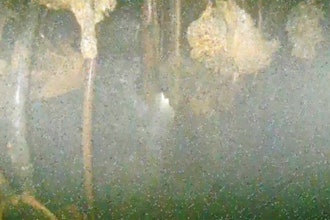TEXAS TOWNSHIP, Mich. (AP) — The way to learn how to make things — is to make something.
While much of education focuses on philosophical and theoretical discussions, an experimental class at Kalamazoo Valley Community College has been focusing on the hands-on processes involved in manufacturing — from design to fabrication.
Mach 282 — short for the Machine 282 class — was experimental not only in its unique structure, which allowed students to design and create a product in a 13-week class, but also in its focus: wind turbines, which supported the college's innovative Wind Energy Technology certificate program to train workers to install, maintain and service wind turbines.
"What we wanted to accomplish was for the students to develop some skills to design and manufacture a wind turbine," said Howard Carpenter, a KVCC machine tool and material science faculty member. "But we are also teaching skill development that wasn't so much about the actual wind turbine. We wanted them to develop the skills to actually do something. You can't just start imagining things with no skills."
Erick Martin, the lead instructor for KVCC's welding program, said, "The intent was to show the process. Most people want to get straight to the end product."
With support from KVCC President Marilyn Schlack, the class received an $89,000 grant from the KVCC Foundation. Most of the money was spent on materials and computer design software. The class, which was team taught by Carpenter, Martin and electrical technology instructor William Wengler and drafting and design faculty Rick Garthe, ran last fall and winter. Plans are to offer it annually beginning in January.
While some students enrolled in the class to get an employment edge in the wind technology industry, others such as student Hether Frayer, were driven by their interest in renewable energy.
Describing herself in the video as a "light green" person, Frayer said a trip to the Columbia River Gorge, where there are numerous wind farms, inspired her to consider the possibilities of wind technology.
"It was a way for me to get an understanding of how wind energy works," she said, though she acknowledges that the class' fast pace and emphasis on design and fabrication left her feeling overwhelmed.
Frayer's reaction was not unusual, Carpenter said. The students were under tremendous pressure, he said.
"First, they were overwhelmed just by deciding what they were going to do," he said. "They had to gather a lot of information. They looked at a lot of wind turbine designs available commercially and theoretical designs. We wouldn't let them copy a design. Their designs had to be something different."
The second main challenge was the actual manufacturing, coming up with the processes and tooling needed to take the design to reality — and to do it on a deadline. Forty percent of the final grade depended on the construction of a working turbine. The added pressure on the winter class was to build the turbine's generator.
"The process was pretty amazing, the way the different instructors interacted with each other and us and how much was in our hands. It was all on the table. Anything was possible," Frayer said. "I wouldn't have understood how complicated the machines are without seeing every tiny piece that went into it."
Carpenter sees the class as one more piece in the network of alternative energy studies KVCC is opening to students. In addition to the wind energy program, the college's heating and ventilation program offers classes on renewable energy and geothermal heating, while the automotive division has an alternative fuels class.
"We still are missing solar energy, but we have to bring all of that together into a comprehensive renewable energy program," Carpenter said. "That's where we see this going."
Carpenter and Martin said they hope the class inspires an entrepreneurial spirit among students. Michigan was a manufacturing state and it can be again, Martin said, but educators must redefine what manufacturing means to students and workers. Manufacturing cannot be defined as finding a job on an assembly line, Martin said. Today, it must be about flexibility and innovation.
"The real innovation is going to be in smaller corporations who are much more nimble and able to produce a variety of products," he said. "It won't be about huge corporations anymore."
The class taught the basics of design and tooling, but more importantly it emphasized concepts such as time management, research, teamwork, communication and adaptation.
"People in the course learned manufacturing is much more elaborate than they think it is," Martin said. "You can't draw something out on a napkin and say, 'This is the deal.' Things don't magically happen. You have to learn teamwork, cooperation and just plain old bullheadedness and sticking to a project through the ups and downs."
___
Information from: Kalamazoo Gazette, http://www.mlive.com/kalamazoo






















